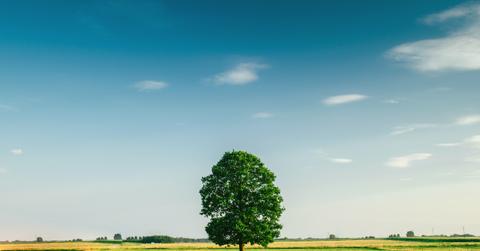Startup Plans To Plant 1 Billion Trees A Year With Drones
BioCarbon Engineering is using drones to help restore forests in Myanmar and will be monitoring results to continue improving their planting methods.
Updated May 25 2019, 8:32 p.m. ET
Human hands won’t be able to reverse the effect deforestation has had in the world without some help from technology. We’ve had amazing efforts, such as India planting 66 million trees in 12 hours, but that was a large-scale event that’s difficult to recreate on a regular basis. Luckily, a startup is looking to cut out the labor hours involved while also drastically increasing the amount of seeds planted every day.
BioCarbon Engineering is planning to use drones to plant up to one billion trees per year. It's already begun work along the Irrawaddy River in Myanmar, where the company is restoring local mangrove forests. Fast Company notes that it has taken over five years for local villagers to plant 2.7 million trees, and these drones would be “10 times faster than humans planting trees by hand, while the process can cost half as much.”
Lauren Fletcher, CEO of the company and former NASA engineer, says that planting by hand is simply too slow to keep up with industrial deforestation. He believes that they have a solution that could change the world and it could have an impact on climate change. He explains, “We’re hoping that our technology can provide opportunities to really scale up the reforestation and replanting rates.”
While the major event in India was a wild success, we don’t exactly know how many trees are going to end up sprouting fully. Drones planting these seeds would increase efficiency because it’s much different than helicopter spray-planting. Part of the reason is due to the intensive planning done prior to delivery. BioCarbon gathers and analyzes all sorts of information, such as surface topology, surface composition, soil type, and moisture in the area.
By deeply analyzing the ground these seeds are planted in, the company can avoid planting in areas where trees would be doomed from the start. They also have the ability to plant multiple species at once. According to the company website, “it is generally advantageous to have a heterogeneous mix of tree species planted in the same area.”
These drones are able to successfully carry multiple seeds because of their unique design. They’re in biodegradable seedpods that are synced up “to ensure high germination rates.” After planting, BioCarbon will continue to monitor the area and does more evaluation to make the next batch of planting even more successful. This is the real benefit of using the drone system.
In addition to the project in Myanmar, the company has also conducted tests in the United Kingdom, Australia, and Canada. Irina Fedorenko, one of BioCarbon’s co-founders, tells Fast Company that “survival rates are definitely much better than spreading from a helicopter” and in some case “it’s comparable with hand planting.”
Ultimately, it is up to local government laws on drones that will impact the speed of planting as each need to be manned by humans in some countries.
